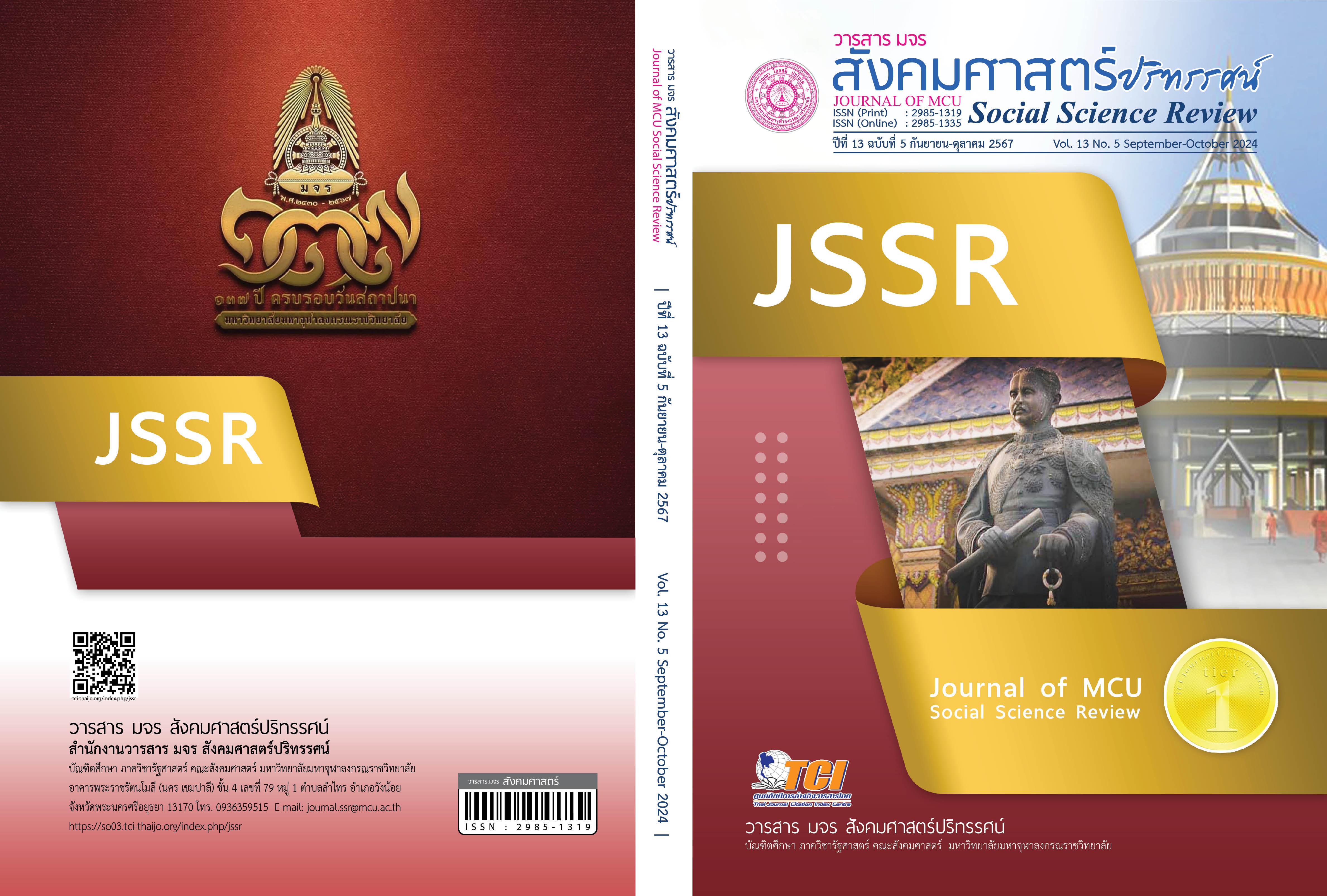พุทธศิลปกรรมบำบัด : เครื่องสักการะล้านนาบูชาพระบรมธาตุดอยสุเทพ ชุมชนบ้านดอยสุเทพ อำเภอเมือง จังหวัดเชียงใหม่
คำสำคัญ:
พุทธศิลปกรรมบำบัด, หลักการดำเนินชีวิต, เครื่องสักการะล้านนาบทคัดย่อ
บทความวิจัยนี้มีวัตถุประสงค์ 1. ศึกษาบริบทชุมชน วัด และทุนวัฒนธรรมที่ปรากฏในชุมชนดอยสุเทพ อำเภอเมือง จังหวัดเชียงใหม่ 2. ศึกษาวิเคราะห์งานพุทธศิลปกรรมในชุมชนดอยสุเทพ อำเภอเมือง จังหวัดเชียงใหม่ 3. การสร้างงานเครื่องสักการะล้านนาผ่านพุทธศิลปกรรมบำบัด ชุมชนบ้านดอยสุเทพ อำเภอเมือง จังหวัดเชียงใหม่ เป็นการศึกษาวิจัยเชิงคุณภาพประกอบกับการสัมภาษณ์ผู้ให้ข้อมูลสำคัญ จำนวน 12 รูปหรือคน คัดเลือกจาก
ผู้ที่อาศัยอยู่ในชุมชน วิเคราะห์ข้อมูลเชิงพรรณนา
ผลการวิจัยพบว่า 1. บริบทชุมชน วัด พุทธศิลปกรรม และทุนวัฒนธรรมที่ปรากฏในชุมชนดอยสุเทพ อำเภอเมือง จังหวัดเชียงใหม่ พื้นที่ศึกษาวิจัย คือ หมู่ที่ 9 บ้านดอยสุเทพ เป็นชุมชนดอยสุเทพพลาซ่า ตามประวัติเชื่อกันว่าชื่อดอยสุเทพได้รับแรงจูงใจจากฤๅษีวาสุเทพ นามว่า สุเทวะ ซึ่งตรงกับคำว่าสุเทพอันเป็นที่มาของชื่อดอยสูงแห่งนี้ ปัจจุบันเป็นชุมชนที่มีการพัฒนาการสร้างงานศิลปะที่เรียกว่าเครื่องสักการะบูชาพระบรมธาตุดอยสุเทพ 2. วิเคราะห์งานพุทธศิลปกรรมในชุมชนดอยสุเทพ อำเภอเมือง จังหวัดเชียงใหม่ เครื่องสักการะเป็นสิ่งสำคัญในศาสนพิธีและเป็นของสูงประกอบพิธีกรรมทางพระพุทธศาสนา มีนัยความหมายเชิงคุณธรรม สอดแทรกหลักจริยธรรม และต้องประดิษฐ์อย่างประณีตบรรจง เครื่องสักการะพระบรมธาตุสุเทพของล้านนาเป็นที่รู้จักกันอย่างแพร่หลาย ได้แก่ ต้นดอก 3. การสร้างงานเครื่องสักการะล้านนาผ่านพุทธศิลปกรรมบำบัด ชุมชนบ้านดอยสุเทพ ประกอบด้วย 1. กระบวนการคิดสร้างสรรค์เป็นการจัดการท่าทาง การจัดวางอุปกรณ์ และเลือกสรรวัสดุต่าง ๆ ที่เหมาะสมและประณีต 2. การออกแบบเป็นความสามารถทางฝีมือสร้างสรรค์ และอารมณ์ของมนุษย์ 3. การวางลวดลายเป็นการทำลวดลายที่ง่ายและสวยงามแบบท้องถิ่นล้านนา 4. การขึ้นรูปเป็นการจัดวางชิ้นส่วนแต่ละชิ้นตามลายที่ประดิษฐ์ขึ้น 5. การตกแต่งเป็นการเลือกใช้ดอกไม้ที่หาได้ง่ายในจากท้องถิ่นและออกดอกตามฤดูกาล
เอกสารอ้างอิง
ชัปนะ ปิ่นเงิน. (2552). จักกวาฬทีปนี : ต้นแบบทางความคิดพุทธลักษณ์ล้านนา. เชียงใหม่: มหาวิทยาลัยเชียงใหม่.
ฐิติพร สะสม. (2561). ศึกษาวิเคราะห์เครื่องสักการะเพื่อเป็นพุทธบูชาของล้านนา จังหวัดน่าน (รายงานการวิจัย). พระนครศรีอยุธยา: มหาวิทยาลัยมหาจุฬาลงกรณราชวิทยาลัย.
ธรรญชนก คําแก้ว (2555) . การวิเคราะห์ความพึงพอใจของนักท่องเที่ยวที่มีต่อแหล่งท่องเที่ยวเชิงวัฒนธรรม ประเภทโบราณสถาน : กรณีศึกษา พระอารามหลวงในเขตอําเภอเมือง จังหวัดเชียงใหม่ (รายงานการวิจัย). เชียงใหม่: มหาวิทยาลัยแม่โจ้.
บุญชู โรจนเสถียร. (2548). ตำนานสถาปัตยกรรมไทย 2. กรุงเทพฯ: บริษัทโรงพิมพ์ กรุงเทพ (1984) จำกัด.
ปัญญา เทพสิงห์. (2548). ศิลปะเอเชีย. กรุงเทพฯ: บริษัทแอคทีฟ พริ้นท์ จำกัด.
พระครูธีรสุตพจน์ (สง่า ธีรสํวโร) และพัลลภ หารุคำจา. (2560). การศึกษาองค์ประกอบพุทธสถาปัตยกรรมและภูมิทัศน์วัฒนธรรมของวัดในอำเภอเมืองเชียงใหม่ (รายงานการวิจัย). พระนครศรีอยุธยา: มหาวิทยาลัยมหาจุฬาลงกรณราชวิทยาลัย.
พระครูภัทรจิตตาภรณ์ (ประสิทธิ์ ภทฺรจิตฺโต) และคณะ (2561). การศึกษาเครื่องสักการะหรือเครื่องประกอบพิธีทางพระพุทธศาสนา ในภาคตะวันออกเฉียงใต้ (รายงานการวิจัย). พระนครศรีอยุธยา: มหาวิทยาลัยมหาจุฬาลงกรณราชวิทยาลัย.
พระครูสิริบรมธาตุพิทักษ์ (อาทิตย์ อธิปญฺโ). และคณะ (2565). การพัฒนาพิพิธภัณฑ์ชุมชนเพื่อการเรียนรู้งานสร้างสรรค์ทางศิลปะ (รายงานการวิจัย). พระนครศรีอยุธยา: มหาวิทยาลัยมหาจุฬาลงกรณราชวิทยาลัย.
พระพรหมคุณาภรณ์ (ป.อ. ปยุตฺโต). (2551). พจนานุกรมพุทธศาสน์ฉบับประมวลศัพท์ (พิมพ์ครั้งที่ 12). กรุงเทพฯ: มหาวิทยาลัยมหาจุฬาลงกรณราชวิทยาลัย.
มหาจุฬาลงกรณราชวิทยาลัย. (2539). พระไตรปิฎกภาษาไทย ฉบับมหาจุฬาลงกรณราชวิทยาลัย. กรุงเทพฯ: โรงพิมพ์มหาจุฬาลงกรณราชวิทยาลัย.
ศักดิ์ชัย เกียรตินาคินทร์. (2542). ความสัมพันธ์ระหว่างคุณค่าศิลปกรรมกับการสร้างทัศนคติต่อตนเองและความผูกพันกับชุมชน. กรุงเทพฯ: จุฬาลงกรณมหาวิทยาลัย.
สงวน รอดสุข. (2533). พุทธศิลป์สุโขทัย. กรุงเทพฯ: สำนักพิมพ์โอเดียนสโตร์.
สรัสวดี อ๋องสกุล. (2529). ประวัติศาสตร์ล้านนา. เชียงใหม่: มหาวิทยาลัยเชียงใหม่.
สายอักษร รักคง. (2564). จิตวิญญาณแห่งความเป็นไทยผ่านภาพลักษณ์ทางศิลปะบำบัดจิต (วิทยานิพนธ์ศิลปมหาบัณฑิต สาขาวิชาทัศนศิลป์). นครปฐม: สถาบันบัณฑิตพัฒนศิลป์.
สุชัย สิริรวีกูล และคณะ. (2566). พุทธศิลปกรรมบำบัด : สร้างสรรค์ลวดลายพุทธศิลปกรรมล้านนาสู่ชุมชนวัดสามขา ตำบลหัวเสือ อำเภอแม่ทะ จังหวัดลำปาง. วารสารวิทยาลัยสงฆ์นครลำปาง, 12(3), 79-98.
อุดม เชยกีวงศ์. (2550). พระเจ้ามังรายมหาราช (พญามังรายมหาราช). กรุงเทพฯ: สำนักพิมพ์ภูมิปัญญา.
ดาวน์โหลด
เผยแพร่แล้ว
รูปแบบการอ้างอิง
ฉบับ
ประเภทบทความ
สัญญาอนุญาต
ลิขสิทธิ์ (c) 2024 วารสาร มจร สังคมศาสตร์ปริทรรศน์

อนุญาตภายใต้เงื่อนไข Creative Commons Attribution-NonCommercial-NoDerivatives 4.0 International License.
เพื่อให้เป็นไปตามกฎหมายลิขสิทธิ์ ผู้นิพนธ์ทุกท่านต้องลงลายมือชื่อในแบบฟอร์มใบมอบลิขสิทธิ์บทความให้แก่วารสารฯ พร้อมกับบทความต้นฉบับที่ได้แก้ไขครั้งสุดท้าย นอกจากนี้ ผู้นิพนธ์ทุกท่านต้องยืนยันว่าบทความต้นฉบับที่ส่งมาตีพิมพ์นั้น ได้ส่งมาตีพิมพ์เฉพาะในวารสาร มจร สังคมศาสตร์ปริทรรศน์ เพียงแห่งเดียวเท่านั้น หากมีการใช้ภาพหรือตารางหรือเนื้อหาอื่นๆ ของผู้นิพนธ์อื่นที่ปรากฏในสิ่งตีพิมพ์อื่นมาแล้ว ผู้นิพนธ์ต้องขออนุญาตเจ้าของลิขสิทธิ์ก่อน พร้อมทั้งแสดงหนังสือที่ได้รับการยินยอมต่อบรรณาธิการ ก่อนที่บทความจะได้รับการตีพิมพ์ หากไม่เป็นไปตามข้อกำหนดเบื้องต้น ทางวารสารจะถอดบทความของท่านออกโดยไม่มีข้อยกเว้นใดๆ ทั้งสิ้น





